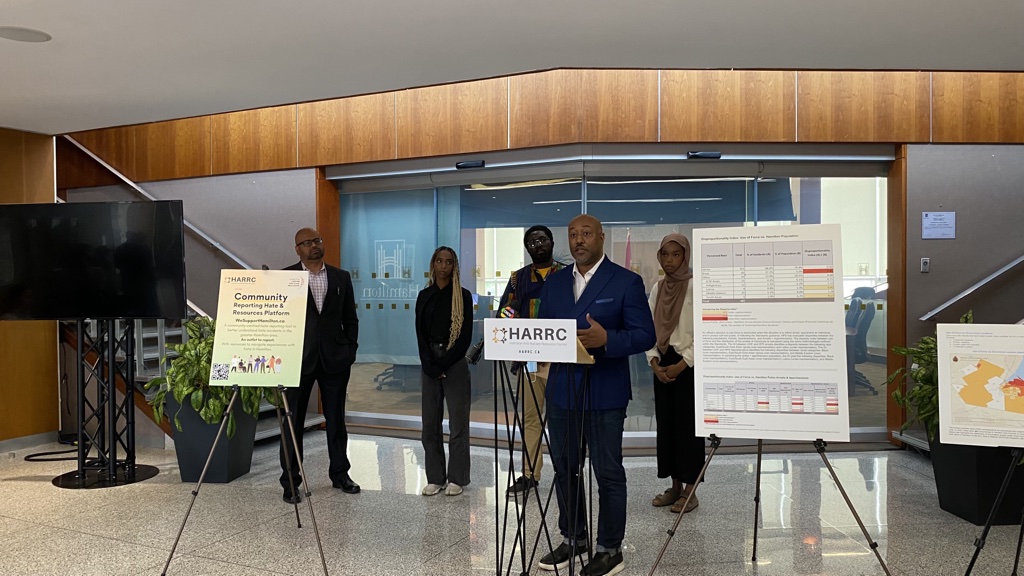A newly released Hamilton police (HPS) report has sparked calls for action from anti-racism advocates after numbers suggested Black people were “over-represented” during use-of-force (UOF) incidents last year.

Several local anti-racism advocates expressed concerns this week over a section of the HPS’ annual UOF statistical report which proclaimed Black people were disproportionately involved during UOF incidents in Hamilton last year.
“So many folks do not feel comfortable having daily interactions with police to even report things that have happened to them,” Koubra Haggar of the Hamilton Centre for Civic Inclusion suggested.
“They do not feel comfortable bringing these things up to police when these are the numbers that come out of the interactions folks have with police officers.”
The “disparity index” was the focal point of the UOF report saying the Black population had a “gross over-representation” during engagements with the HPS last year.
The report declared negative interactions between local police and the Black population in 2022 were three times more likely to happen when compared with other defined groups.
Lyndon George of the Hamilton Anti-Racism Resource Centre said the data reflects a need for change and that he’s observed a “concerning pattern” by the Hamilton Police Service Board and HPS when it comes to the use of force data.
“Trust must be a fundamental part of community policing,” said George. “It requires the community to believe that they will receive equal protection under the law. Today’s data puts that fundamental trust into question.”
- Infant, grandparents killed in Highway 401 crash after police pursuit from LCBO robbery
- London sword attack: 14-year-old killed, 4 injured by man on stabbing spree
- Trump faces jail threat as judge fines him for breaking gag order during trial
- Parents of slain Halifax teen grapple with grief, anger: ‘No one listened’
George says the city’s Black community also topping HPS’ hate/bias crimes report, suggesting they are one of the “most frequently victimized” groups, presents a “fundamental problem” that requires more trust, transparency and change at the board level.
“It’s critical these conversations are happening at the table where the priorities and objectives are being determined. The time to act is now,” he suggested.
However, HPS chief Frank Bergen says the data, suggesting officers use more force in incidents involving Black people, doesn’t mean that segment is being “targeted.”
But Bergen says the “gross over-representation” tag that showed up in the study is just a required reporting tool under Ontario’s Anti-Racism Data standard – to help the province monitor systemic racism and racial disparities within the public sector.
“So that language of 3.1 (times), which we saw and we’ve heard loud and clear, doesn’t mean that they’re actually being ‘targeted’ … three times more,” Bergen explained.
The report included a required ‘Disparity Index’ section that uses indexes to compare the number of UOF incidents with the noted race of any suspect.
Based on the province’s anti-racism standard, officers are expected to judge a person through seven categories – Black, East/Southeast Asian, Indigenous, Latino, Middle Eastern, South Asian and White.
There is no option for officers to select unknown.
HPS’ Bergen says the disparity index doesn’t actually define what an incident was, but uses a “lens” based on the anti-racist standard to create a value.
“And that value is based on officer bias, institutional cultural practices, persons’ choice in actions and social and demographic factors,” he said.
“We do not create that filter.”
He goes on to suggest using the disparity index formula against some 7,600 arrests and 2,100 apprehensions made by HPS in 2022 actually points to a lower threshold.
“When you do that same disparity index in that area … is that the East and South Asian community were represented over 4.34 per cent, and in this particular case, the black community was 1.58 (per cent)” Bergen explained.
The ‘disparity index’ was the focal point of the UOF report this week with Hamilton’s anti-racism advocates coming out in numbers to suggest more action needs taken in response to the “gross over-representation” tag in interactions with the Black population.
Meanwhile, Hamilton police chair Pat Mandy and mayor Andrea Horwath have had similar reactions to the overall UOF report submitting there are unanswered questions coming from the data.
Mandy wants more studies to “better understand” what is driving the data being collected.
“I think it would be very important that we need to engage the community plus our research partners at McMaster … and other studies,” said Mandy.
Horwath, who is on the police services board, believes more needs to be “layered” onto how data is tracked and that more engagement with the community is needed.
“I mean, data is important but unless you determine what it’s useful for or how to utilize it or how to … act on it, really it’s just a bunch of numbers,” Horwath said.
Bergen says HPS is working on adopting a “standardized provincial strategy” to deal with race-based data and that community consultation will be part of that work.
The service is expected to open up public consultation in the fall about what the police’s role will be in working with the community.
“That’s a great opportunity to also set us up for understanding the data as we go into collection and reporting next year,” Bergen explained.






Comments